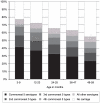The prevalence and risk factors for pneumococcal colonization of the nasopharynx among children in Kilifi District, Kenya
- PMID: 22363489
- PMCID: PMC3282706
- DOI: 10.1371/journal.pone.0030787
The prevalence and risk factors for pneumococcal colonization of the nasopharynx among children in Kilifi District, Kenya
Abstract
Background: Pneumococcal conjugate vaccines (PCV) reduce nasopharyngeal carriage of vaccine-serotype pneumococci but increase in the carriage of non-vaccine serotypes. We studied the epidemiology of carriage among children 3-59 months old before vaccine introduction in Kilifi, Kenya.
Methods: In a rolling cross-sectional study from October 2006 to December 2008 we approached 3570 healthy children selected at random from the population register of the Kilifi Health and Demographic Surveillance System and 134 HIV-infected children registered at a specialist clinic. A single nasopharyngeal swab was transported in STGG and cultured on gentamicin blood agar. A single colony of pneumococcus was serotyped by Quellung reaction.
Results: Families of 2840 children in the population-based sample and 99 in the HIV-infected sample consented to participate; carriage prevalence was 65.8% (95% CI, 64.0-67.5%) and 76% (95% CI, 66-84%) in the two samples, respectively. Carriage prevalence declined progressively with age from 79% at 6-11 months to 51% at 54-59 months (p<0.0005). Carriage was positively associated with coryza (Odds ratio 2.63, 95%CI 2.12-3.25) and cough (1.55, 95%CI 1.26-1.91) and negatively associated with recent antibiotic use (0.53 95%CI 0.34-0.81). 53 different serotypes were identified and 42% of isolates were of serotypes contained in the 10-valent PCV. Common serotypes declined in prevalence with age while less common serotypes did not.
Conclusion: Carriage prevalence in children was high, serotypes were diverse, and the majority of strains were of serotypes not represented in the 10-valent PCV. Vaccine introduction in Kenya will provide a natural test of virulence for the many circulating non-vaccine serotypes.
Conflict of interest statement
Figures
References
-
- O'Brien KL, Wolfson LJ, Watt JP, Henkle E, Deloria-Knoll M, et al. Burden of disease caused by Streptococcus pneumoniae in children younger than 5 years: global estimates. Lancet. 2009;374:893–902. - PubMed
-
- Berkley JA, Lowe BS, Mwangi I, Williams T, Bauni E, et al. Bacteremia among children admitted to a rural hospital in Kenya. N Engl J Med. 2005;352:39–47. - PubMed
-
- O'Dempsey TJ, McArdle TF, Lloyd-Evans N, Baldeh I, Lawrence BE, et al. Pneumococcal disease among children in a rural area of West Africa. Pediatr Infect Dis J. 1996;15:431–437. - PubMed
-
- Campbell JD, Kotloff KL, Sow SO, Tapia M, Keita MM, et al. Invasive pneumococcal infections among hospitalized children in Bamako, Mali. Pediatr Infect Dis J. 2004;23:642–649. - PubMed
-
- Valles X, Flannery B, Roca A, Mandomando I, Sigauque B, et al. Serotype distribution and antibiotic susceptibility of invasive and nasopharyngeal isolates of Streptococcus pneumoniae among children in rural Mozambique. Trop Med Int Health. 2006;11:358–366. - PubMed
Publication types
MeSH terms
Substances
Grants and funding
LinkOut - more resources
Full Text Sources
Medical



